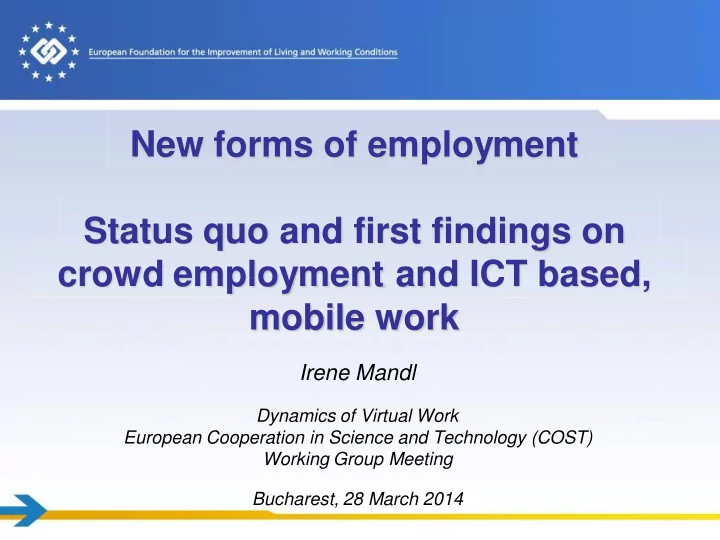

New forms of employment Status quo and first findings on crowd employment and ICT based, mobile work Irene Mandl Dynamics of Virtual Work European Cooperation in Science and Technology (COST) Working Group Meeting Bucharest, 28 March 2014
Background and objectives • Anecdotal evidence of the emergence of new employment forms • Little information on Their specific characteristics Their impact on working conditions Their effects on the labour market • Eurofound project in WP 2013 and 2014 to Identify and characterise the new employment forms in Europe Illustrate their implications on working conditions and the labour market Illustrate their legal and policy framework Derive some policy pointers
Methodology and status Mapping exercise May – December 2013 • Identification of new employment forms by national correspondents Systematisation/classification by Eurofound Literature review October 2013 – June 2014 • By Eurofound and contractors To characterise the employment forms and summarise findings on implications on working conditions and the labour market Case studies November 2013 – August 2014 • By contractors, with pilots by Eurofound Employment relationships, legislation, collective agreements, support instruments To illustrate selected new employment forms and their implications on working conditions and the labour market • Reporting By Eurofound Publication planned for end of 2014/early 2015
What is a ‘new form of employment’? Established or of increasing importance since about 2000
Identified new employment forms Employee Job Temp. Casual ICT Portfolio Voucher Crowd Coopera- sharing sharing work work manage- based, based employ- tion ment work ment mobile among work self- employed Employees Both Self-employed, freelancers, micro enterprises Employment Employment terms Networking relationship
Identified new employment forms By target group and country Yellow – rather employees Blue – rather self-employed Orange – both
Case studies • Crowd employment: CZ, DE, DK, ES, LT, LV, PT, UK • ICT based, mobile work: DK, EL, FI, LV, NL, NO, SE, SI • Employee sharing: (AT), BE, CZ, DE, FI, FR, HU, LU • Temporary management: CZ • Casual work: HU, IE, NL, RO, UK • Job sharing: CZ, SI, SK, PL • Service vouchers: (AT), BE, EL, IT, LT • Coworking: DE, ES In total, 60+ case studies
Crowd employment Emergence in Europe Yellow – yes Brown – no
Crowd employment Analysed platforms • CZ: Top designer • DE: clickworker • DK: Boblr • ES: Adtriboo • LT: lingjob • LV: Academy ideas • PT: Idea hunting • UK: Amazon Mechanical Turk, Task hub
Crowd employment Working method
Crowd employment Commonalities of approaches • No specific legal framework • Very recent establishment of the platforms • Coverage Mainly creative activities Mainly national clients Rather young workers Spare- time, ‘next to something’ activities • Motivation for clients Access to a large pool of resources Flexibility Costs • Motivation for workers Interest in the work offered Access to job opportunities Potential to improve employability
Crowd employment Heterogeneity of approaches (1) • Initiator and ownership structure Spin-off or subsidiary of larger companies Owner-manager • Eligibility Open for all vs. for registered users Immediate publishing of offered tasks vs. check by platform management • Working method Competition crowdsourcing Procurement of tasks by the client Offering of services by the worker Non-virtual service provision
Crowd employment Heterogeneity of approaches (2) • Payment On agreement between client and worker vs. minimum/fixed price given by platform management Direct payment vs. through the platform • Funding Registration fee Publishing fee Commission fee
Crowd employment Implications on working conditions • Flexibility • Autonomy • Virtually no job and employment security • Virtually no social protection • Potential of increased employability and career development • Small additional income
Crowd employment Labour market effects • Increased flexibility and productivity • Access to work opportunities • Potential of labour market integration of disadvantaged groups • Enhancement of skills and experience • Potential to establish client networks Possibility to ‘try’ self -employment/freelance activities • • Potential transformation from dependent employment to self- employment in certain sectors Potential crowding out of ‘standard jobs’ •
ICT based, mobile work Emergence in Europe Yellow – yes Green – no
ICT based, mobile work Analysed cases • DK: Grontmij • EL: Microsoft Hellas • FI: Suomen Pienyrittäjäin Mainostoimisto • LV: Belam-Riga Ltd • NL: YoungCapital • NO: HP Norway • SE: Engbergs Transportsystem • SI: Faculty of Social Sciences at the University of Ljubljana
ICT based, mobile work The concept Source: Schaffers et al. (eds.), 2006
ICT based, mobile work Structural characteristics • Heterogeneity of sectors, company size and ownership/management structure • Rather young workers • Rather high-skilled specialists, management • In general permanent full-time employment contracts • Introduction in the mid/late 2000s
ICT based, mobile work Main characteristics • No specific legal framework • Motivation for the employer Innovation of work organisation Attracting skilled labour Efficiency and productivity gains Lack of office space • Motivation for the workers: flexibility • Preconditions Technical set-up Suitability of jobs/tasks Trust • Rather informal implementation and procedures
ICT based, mobile work Implications on working conditions • Flexibility/autonomy regarding working time and work organisation • Some risk of unpaid overtime • Partly higher stress levels and expections to be ‘ always available ‘ experienced • ‘Outsourcing‘ of health & safety responsibility • Mixed assessment of access to information and knowledge sharing • Feeling of isolation and loss of socialisation • Higher employee satisfaction
ICT based, mobile work Labour market effects • Potential of labour market integration of disadvantaged groups • Mixed assessment of work-life balance • Improved quality of the work conducted • Efficiency and productivity gains • Cost reduction • Positive impact on employer branding
Thank you for your attention! Irene Mandl, Irene.Mandl@eurofound.europa.eu
Recommend
More recommend